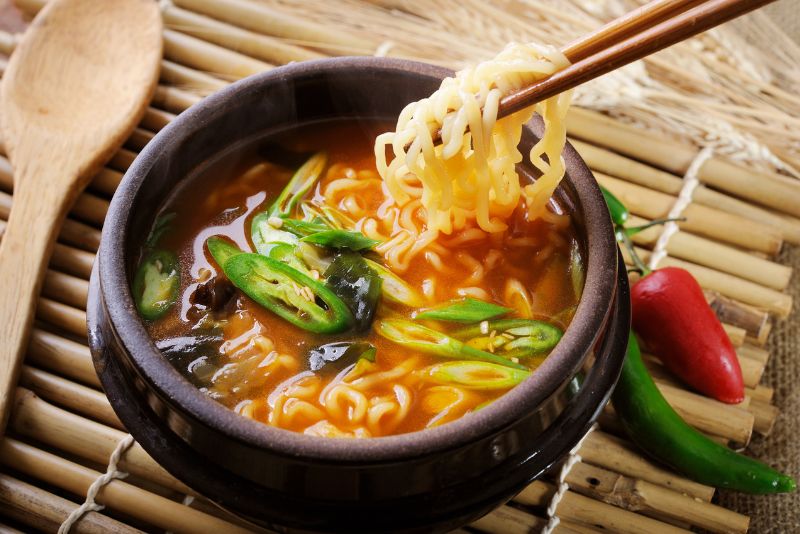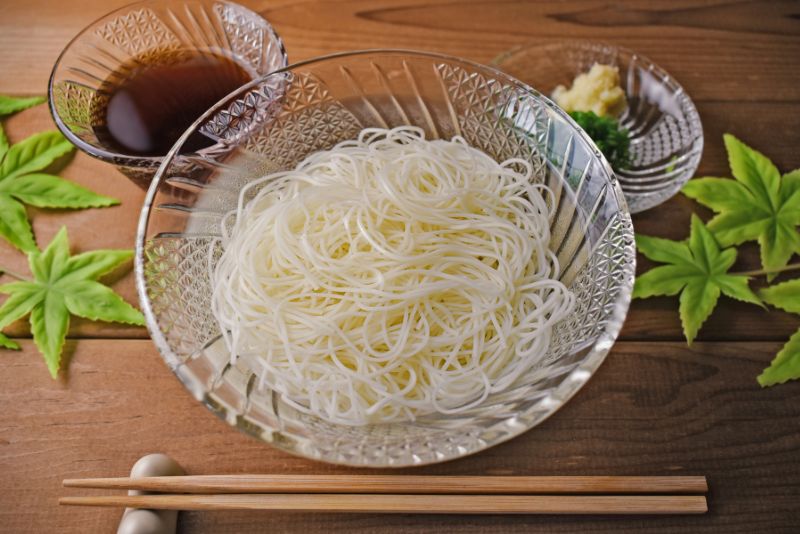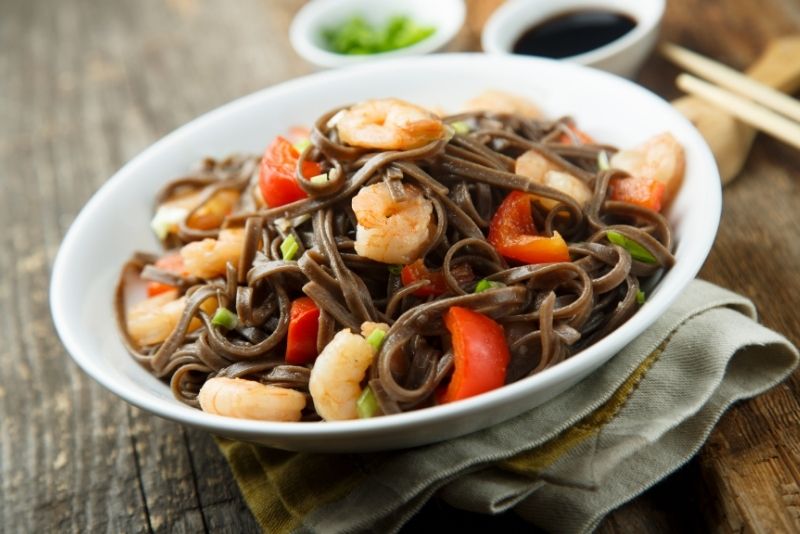Soba noodles are traditional Japanese noodles made from buckwheat flour and served chilled with dipping sauce. They can be found in many Asian restaurants around the world as well as in Japanese home kitchens.
They’re usually sold dried, so they typically need to be cooked before eating. If you love eating Soba noodle dishes, but can’t find them or you do not like all of the carbs that come with them, it might be time for a change.
There are many different types of noodles that could serve as a great replacement for soba noodles.
Table of Contents
7 Best Soba Noodles Substitutes
The best substitutes for Soba Noodles are whole wheat spaghetti and ramen noodles. You can also use udon noodles, yakisoba noodles, and kelp noodles as substitute for soba noodles.
If you’re looking for an alternative that is just as tasty and easy to cook, then this article will help you find the best soba noodles substitutes and how to use them in your favorite dish.
1. Whole Wheat Spaghetti
Whole wheat spaghetti is one of the best alternative to soba noodles. It has a similar flavor and texture, but it’s much healthier than its traditional counterpart.
This noodle substitute boasts nearly twice as much protein and three times as much fiber as traditional soba noodles. This means you’ll get more nutrients with fewer carbs when you opt for this noodle substitute.
Also, the noodles are light brown in color which makes them interesting to look at if you want something different than traditional soba noodles. You can buy whole wheat spaghetti in most grocery stores or online.
2. Ramen Noodles

Ramen noodles are another popular Asian noodle that you could try as a substitute. These noodles are typically sold in dry form and they’re great for making soup.
You can find ramen noodles online or at many grocery stores. They come packaged with seasoning, so you can save even more time by adding water and microwaving them instead of cooking them on the stovetop.
3. Udon Noodles
Udon noodles are another Japanese noodle that is typically served in soup or stir-fried with vegetables. They’re much thicker than soba noodles, but they still retain the same flavor and texture.
These noodles are sold dried in many groceries stores, making them easy to find unless you don’t have a large Asian grocery store nearby.
4. Yakisoba Noodles
Yakisoba can also be used as soba noodle replacement. They are a type of Japanese noodles typically found in stir-fries and other dishes that feature vegetables and fried meat.
These noodles resemble ramen or soba noodles, but they also have a hint of sweetness to them. They’re typically sold dried and cooked similarly to the other noodle substitutes on this list.
You can find yakisoba noodles at most Asian grocery stores and online. They’re relatively inexpensive compared to other noodle substitutes, so they might be worth trying just once or twice before you decide whether or not they’re for you.
5. Rice Noodles
Rice noodles are one of the more familiar substitutes on this list. They are used in nearly every Asian dish that features rice noodles, so you’ve probably already tried them before.
These noodles can be purchased at most Asian grocery stores and they’re also fairly inexpensive.
You should buy rice noodles that resemble spaghetti instead of those that look like flat pieces of paper or packages of other flatter noodles.
6. Somen Noodles

Somen noodles can be a great soba noodles alternative. These Japanese noodles are slightly thicker than soba, but more similar in appearance and flavor to the more traditional noodles.
These noodles are often enjoyed during cold weather months because they’re said to have a warming effect on your body.
You can easily find Somen noodles at most Asian grocery stores and they’re also sold online.
7. Kelp Noodles
Kelp noodles are actually made from kelp, a type of seaweed plant. They’re usually available for purchase either dried or fresh at health food grocers like Whole Foods Market.
These noodles taste slightly sweet and have a flavor that is unique from any other soba noodle substitute.
Consequently, these noodles don’t have much of a taste on their own so they’re best served with sauces or vegetables to avoid eating them alone.
These are the 7 best soba noodle substitutes available today. They help you save time and money because they can be purchased at most grocery stores and made on a stovetop in a matter of minutes.
What are Soba Noodles?
Soba noodles are a type of Japanese noodle that can be enjoyed hot or cold with a number of different ingredients, including fish, meat, or vegetables.
These noodles are popular in Japan for their versatility and relatively low cost.
Although “Soba” refers to the noodle itself, it’s actually made from buckwheat flour.
💡 Fun fact: Buckwheat is actually a fruit seed and not a grain, despite the name.
This noodle has a nutty flavor that’s delicious when combined with other ingredients or served plain.
Soba is served throughout the country, particularly during cold weather months.
You’ll find the best soba noodle dishes in cities with large Japanese populations, such as New York or Los Angeles. The noodles are also widely available online.
Frequently Asked Questions
What Does Soba Noodles Taste Like?
Soba noodles are slightly nutty, but they’re mostly known for their earthy flavor which comes from buckwheat flour.
If you’ve never had soba noodles before, they have a unique flavor that doesn’t taste like any other noodles. Soba noodles can vary greatly in taste depending on the ingredients used to make them. They are commonly served cold with a dipping sauce, or in a hot broth as a soup.
What Are Soba Noodles Made Of?
Soba noodles are made of buckwheat flour, water, and salt. Sometimes the flour is mixed with wheat flour to make a lighter noodle.
What Kind of Noodles Are Soba Noodles?
Soba noodles are traditional Japanese noodles that are commonly made from buckwheat flour although they can also be found in many different types of flour.
They have a brownish color and are typically served cold in dishes like Zaru soba (recipe) or Nabe. Soba noodles don’t usually contain eggs making them vegan friendly, but some recipes call for eggs.
They also come in thin, medium, and thick varieties depending on what you’re looking for. Soba noodles are typically served in soups or stir-fried with vegetables. Some people even eat them with sauce, but it is less common to find soba being enjoyed in Western dishes. Common toppings for soba noodles include ginger, green onions, and sesame seeds.
Are Soba Noodles and Ramen the Same?
No, soba noodles and ramen aren’t the same and there are many differences between the two.
Soba noodles are made from buckwheat flour, while ramen noodles are made from wheat flour. This means that soba noodles are gluten free, while ramen noodles are not.
Buckwheat is also a lot lighter than wheat, so soba noodles are thinner and have a lighter flavor than ramen noodles. Finally, soba noodles are typically served cold, while ramen noodles are usually served hot.
Can Vegans Eat Soba Noodles?
Yes, vegans can eat soba noodles. Many types of noodles are made entirely from plant-based ingredients making them vegan friendly.
However, some brands will include eggs in their noodle or pasta products which means they’re not suitable for vegans. The best way to ensure that your product is vegan is to check the ingredients label before you buy it.
Are Soba Noodles Gluten-Free?
Yes, soba noodles are gluten-free. Soba noodles are made from buckwheat, which is a type of grain that does not contain any gluten.
Can I Use Udon Noodles Instead of Soba?
Yes, you can use Udon noodles in place of Soba noodles but the flavors will vary.
Udon and soba noodles are both made from buckwheat flour, but the flavors and textures of these two types of noodles are slightly different.
Soba is made with 100% buckwheat flour which makes it darker than other noodles because it’s richer in flavor. It also has a nutty texture which is what gives this type of noodle its inherent taste.
Udon noodles typically contain both wheat and buckwheat flour instead of just buckwheat like soba since they need to be softer than soba noodles.
How Do You Not Overcook Soba Noodles?
The best way to ensure that your soba is cooked perfectly is to taste test them in small intervals of time, checking every minute or two until they’re 100% done.
Soba noodles are cooked in much the same way that other types of noodles or pasta are prepared. Most recipes will cook these noodles in boiling water for a few minutes before draining them and serving them either hot or cold.
Many people make the mistake of letting their soba cook for too long which can cause them to get mushy and lose the flavor of the buckwheat flour.
Final Words
We hope that this list of noodles will help inspire you to change up your Soba noodle dish and try something new.
These soba noodles substitutes are easy, delicious, and healthy; we think they’re perfect for any occasion.
Have you tried any of these substitutes for soba noodles before? Let me know how it went in the comments below.
